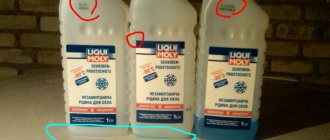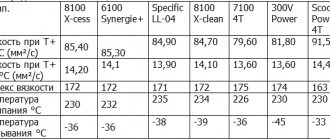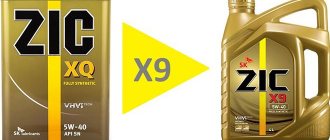Types of base oils
Mineral
. These are the most inexpensive oils, but they have their disadvantages, for example they thicken at low temperatures. The quality of mineral oils is improved only through functional additives (anti-scuff, anti-corrosion, etc.). For long-term operation, it is better to use synthetic oils.
Synthetics
. It is more fluid, and therefore more suitable for use at low temperatures, and in general, synthetic oil is considered all-season. Synthetics age less and are less susceptible to oxidation, but due to their properties and manufacturing complexity they are much more expensive than mineral oils.
Semi-synthetics
. The golden mean, which will cost less than synthetics, but will still be of higher quality than mineral oil and will last 25–30% longer.
What happens if you mix synthetic and mineral oil?
Some “experts” believe that by mixing synthetic and mineral bases, you can get a semi-synthetic substance. This is fundamentally wrong. When mixing different types of compounds, insoluble compounds are formed. The elements precipitate in the form of flakes and lead to blockages in the lines.
The second negative part is the complete destruction of the formulas, with the loss of the protective properties of the finished product. In simple words, when mixing liquids with different bases and additives, they conflict and lose their original properties.
Properties of transmission oils by gearbox type
Automatic transmission oil
(marked ATF) ensures compliance with more stringent requirements than for mechanics. Due to their higher viscosity index, they better resist foaming and oxidation and are less aggressive on elastomer seals. Does it make sense to use such oil in mechanics? Yes, it is much better, but it will also cost more.
Manual transmission oil
(labeled MTF), predominantly mineral and semi-synthetic, removes heat well and protects against rust, successfully reduces mechanical stress.
Differences in viscosity level
The viscosity-temperature properties of oils are a very important parameter, which determines the maximum useful coefficient of the engine with minimal wear of its parts. This parameter is best reflected in the SAE classification - American Association of Automotive Engineers. In it we see a description of the viscosity of oils in different ranges of engine operating temperatures. In fact, this is the optimal temperature range at which a certain type of oil can be used.
- The first number in the encoding.
Consider, for example, SAE 5W-40. 5W indicates that the viscosity is intended for use at low temperatures, but not below -35 °C. We simply subtract 40 from the number that comes before W, and we get the maximum permissible temperature for cold starting the engine. This is just a recommendation, but it's best to follow it. If you live in a region where there are rarely sub-zero temperatures, then it is better to use all-season gear oil coded SAE 75W-90. - Second number
. This is a high-temperature viscosity; here you need to focus solely on the recommendations of the car manufacturer.
On the one hand, increased oil viscosity helps the engine warm up much faster during cold starts. At the same time, the viscosity indicator does not have an absolute value; it changes dynamically depending on the temperature range. That is why you need to follow one rule: strictly follow the recommendations of the automakers. They themselves standardize oils. It should also be added that now all-season synthetic oils are becoming more common, while previously there was a clear division into summer and winter.
Additives
We will separately consider a set of modern additives that allow transmission oils for gearboxes to better cope with their tasks and obtain the necessary performance characteristics.
- Anti-wear
. They function until there is enough oil in the gap between the gears of the gearbox. - Anti-seize.
Particularly useful at high loads, when the degree of friction approaches dry. - Anti-corrosion.
As the name suggests, they provide the gearbox with long-term corrosion protection. - Anti-friction.
They reduce friction and thereby save on fuel. - Antifoam
. Directly affect the quality of lubrication: a large amount of foam leads to a deterioration in the distribution of lubricant throughout the box.
Types of oils
First, let's determine what types of oils can be found on sale.
All automobile oils can be divided into two large categories - motor and transmission.
Transmission fluids are divided into fluids for manual transmissions (MT) and automatic transmissions (AT).
Based on the origin of the base components, motor and transmission oils can be mineral, synthetic or semi-synthetic.
Features of changing transmission oil
Transmission oil must be changed periodically, and this procedure is often more complicated than for engine oil. The replacement period is usually indicated in the car manufacturer's manual and depends on the distance traveled and driving intensity. Car owners often ignore these rules, mistakenly believing that the load on the transmission is less than on the engine.
Automatic transmission
. An oil change plays a particularly significant role in automatic transmissions, where the transmission fluid, in addition to its functions of lubrication and protecting the surface of parts, is a working fluid. There is no point in saving on transmission fluids, because this can lead to damage or a significant reduction in the service life of the gearbox.
CVT gearboxes
. Special attention should be paid to replacing transmission oil in CVT gearboxes, which belong to the automatic class, but operate under very severe temperature conditions. In them, the additive package disintegrates much faster, and it is better to strictly follow the recommendations for replacing the CVT fluid due to high loads.
Maintenance-free gearboxes
. There are cars on the market with so-called maintenance-free gearboxes, that is, they are filled with oil for the entire life of the car, and they do not even have the ability to check the oil level using a dipstick. In practice, after intensive operating modes of the gearbox, they also require timely oil changes, and it is better to have them checked by specialists.
Is replacement possible or not?
Now that some characteristics and properties of both types of lubricants have become known, we can talk about possible replacements. In fact, all experts recommend in such cases to follow the instructions in the operating instructions for the machine. Some front-wheel drive vehicle models allow short-term use of motor oils in gearboxes, but with the caveat that the service life of the mechanisms may be reduced by approximately 30%.
A definite “no” can be said for owners of the “classic”, for whom even replacing the TAD transmission lubricant with TAP leads to accelerated wear of the gearboxes. Sometimes just a few thousand kilometers are enough, and box repair becomes inevitable. If suddenly there is an urgent need for topping up, you can, but only on condition that you drain the lubricant as soon as possible and replace it with a new one recommended by the car manufacturer.
You cannot pour motor oil into robotic gearboxes or CVTs. They have high requirements for oil viscosity, for example 75W90, so be very careful when choosing oil for such units. Saving on transmission lube can result in costly gearbox repairs. We hope that it has become clear to readers whether it is possible to pour engine oil into the box. This is a serious question for those drivers who take good care of their car and are ready to use it for a long time.
During the operation of a vehicle with various types of internal combustion engines and gearboxes, owners are often faced with the need to mix oils and technical fluids. As a rule, difficulties arise during the process of replacing or topping up both engine and transmission oil.
As for the transmission, car enthusiasts in some cases are interested in whether it is possible to pour engine oil into the box, axles, gearboxes, etc. This is due to the fact that modern motor oils are designed for heavy loads, and also contain expanded packages of active chemical additives for operation in the most severe conditions. Let's figure it out.
Let us immediately note that if we are talking about automatic hydromechanical transmissions (automatic transmission or variator), in this case it is better to immediately abandon attempts to fill in engine oil, even in the event of a critical drop in the fluid level in the transmission due to various malfunctions.
The fact is that such a box can fail or work incorrectly even with special ATF fluids that are not recommended by the manufacturer for a particular type of automatic transmission or CVT.
As for manual transmissions and robotic gearboxes, in this case the use of motor oil at first glance may seem quite possible. Moreover, on some auto forums there is information that car enthusiasts are actively experimenting by using engine oil in the gearbox, pouring Dexron into the manual transmission, etc.
- So, first of all, the manufacturers themselves separately produce motor and transmission oils. At the same time, the characteristics of various lubricating fluids from both groups differ markedly.
Transmission and engine oils differ in viscosity index and also have different additive packages that provide the properties necessary for normal operation of the units. However, many owners of front-wheel drive cars, rear-wheel drive VAZ classics and old foreign cars claim that using internal combustion engine oil in a manual transmission can be done without any consequences.
The main argument is the well-known fact that at the initial stage, in the first VAZ models with front-wheel drive, engine oil was poured directly into the box at the factory. At the same time, a detailed study of this issue allows us to conclude that at that time there were simply problems in production with the availability of special transmission oil. It turns out that such a step by the manufacturer can be considered a necessary measure.
You also need to take into account that the transmission structure itself may differ in different cars. This means that while the use of motor oil in a VAZ gearbox may not lead to obvious problems, the same cannot be said about foreign cars, even relatively old ones.
- Let's move on. If we consider the issue of characteristics, we need to consider how gear oil differs from motor oil. Even taking into account the fact that the base may be the same (mineral oil, synthetic or semi-synthetic), the amount and types of additives in the composition are very different.
Is it possible to add engine oil to a manual transmission?
Taking into account the above information, it becomes clear that although some characteristics and properties of lubricants for the engine and transmission are similar, these oils still belong to different groups. At the same time, on some front-wheel drive car models, the use of engine oil in the gearbox is acceptable, but such use should be short-term. Moreover, the service life of the unit may be reduced by at least a third.
As for rear-wheel drive cars, in practice the use of engine oil that is “liquid” is unacceptable. The reason is severe wear and failure of gearboxes, and after just a few thousand km. mileage
We will also add that if it is necessary to add oil to the gearbox in an emergency, you can use motor oil instead of gear oils. It is important to understand that this is a last resort measure. With such a mixture in the box, you can only get to the repair site, and not operate the car.
We also recommend reading the article about whether it is possible to mix gearbox oils. From this article you will learn whether gear oils are compatible with each other, as well as what needs to be taken into account if it is necessary to mix such products with different properties from different manufacturers, etc.
Finally, we note that if the gearbox is completely or partially filled with engine oil for one reason or another, all fluid from the gearbox must be drained in full as soon as possible. Next, the oil in the gearbox is replaced with one recommended by the car manufacturer itself.
How to spot a fake
It is quite difficult for a non-professional to distinguish a counterfeit from the original gear oil, and many motorists discover low quality after the oil has been poured into the gearbox. By what indicators can you distinguish the original?
- Appearance. It must correspond to the description on the manufacturer’s website and have special stickers. Pay attention to the color of the canister: a fake may have a different shade. The lid must be tightly sealed.
- Counterfeit packaging often has a lot of errors and blunders in the text, especially in those places where it is written in small print. Yes, labels can be faked efficiently, but this becomes economically unprofitable.
- The original transmission fluid does not have a burning smell and has a uniform color without inclusions or impurities.
- Branded packaging often has several degrees of protection, including laser engraving, unique batch numbers, holographic stickers, and difficult-to-manufacture forms of canisters and caps. For example, ROLF gear oil is available only in metal cans, which are too complex and unprofitable to replicate, unlike plastic ones.
ROLF gear oil catalog
More details
ROLF ATF II
Multifunctional fluid designed for automatic transmissions with stepped shift. Can be used in power steering. Due to its high heat capacity and stable viscosity at large temperature differences, it helps improve the performance of automatic transmission clutches. Due to its low-temperature properties, the oil protects transmission components during the cold start of the engine.
More details
ROLF ATF Multivehicle
This transmission fluid is especially effective thanks to a rich package of new generation additives. Significantly reduces wear of automatic transmission parts and prevents scuffing. High viscosity ensures stable operation of components in cold climates, and an optimal friction coefficient ensures a smooth gear shifting process.
More details
ROLF Transmission S9 AGE 75W-90
A universal gear oil that is perfect for mixed fleets and has good performance properties. The synthetic base, coupled with an advanced set of additives, gives the oil temperature and antioxidant stability. Can be used in various transmission mechanisms: the chemical composition is compatible with parts made of non-ferrous metal alloys.
More details
ROLF Transmission M5 G 80W-90
All-season mineral gear oil that increases the service life of components and provides optimal protection under high loads. Used in manual transmissions of cars and trucks under conditions of high speeds and medium loads at moderate air temperatures. Reduces noise from a running gearbox due to good friction properties.
More details
ROLF Transmission M5 A-LS 80W-90
High-tech multi-grade transmission oil designed for use in axles with limited slip differentials and a wide range of conventional axles and power take-offs. Perfectly protects gearboxes, bearings, and limited slip elements. Able to protect against scuffing, wear and corrosion.
More details
ROLF Transmission 75W-85 GL-4
Semi-synthetic gear oil for manual transmissions and drive axles, demonstrating excellent performance properties over a wide range of temperatures. Excellent for cleaning gearbox parts. Anti-wear characteristics can extend replacement intervals.
Engine oil in the gearbox: can or cannot be filled
Along with the engine, the gearbox functions constantly, even when the car is running and standing still. Inside the assembly there is a fairly high concentration of moving and rubbing metal parts: shafts, gear shift links, gears, bearings. All these mechanisms require lubrication and cooling.
The transmission fluid inside cannot be universal; each automaker sets its own tolerances. Information about what kind of oil to pour into the box is usually contained in the technical documentation for the car, except in cases where the manufacturer recognizes the manual transmission as maintenance-free. This does not mean that replacing the transmission is not required.









